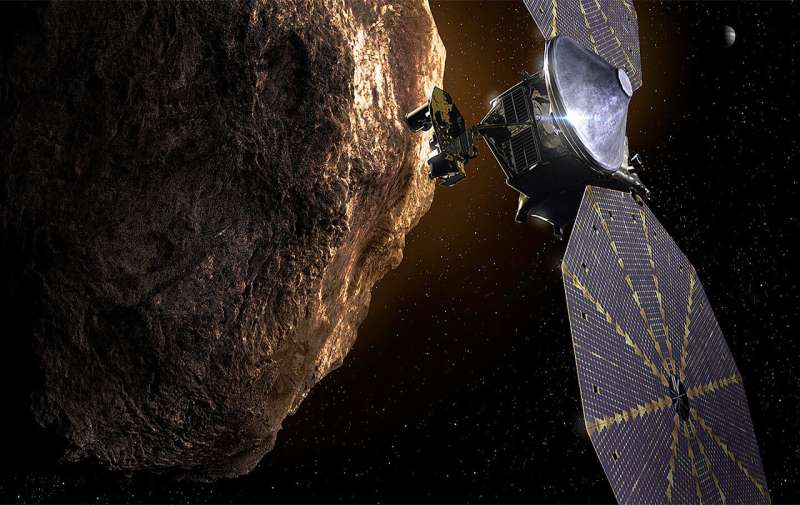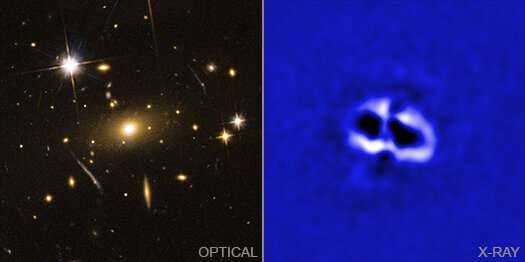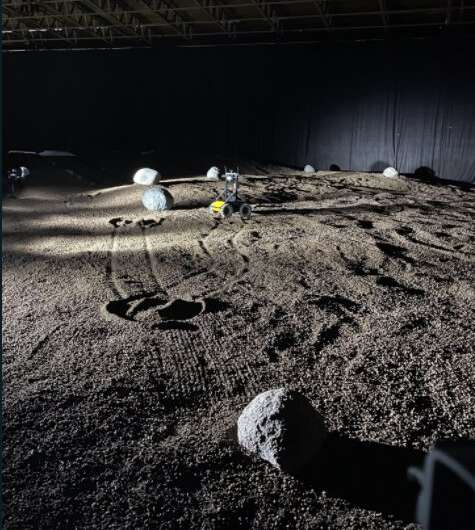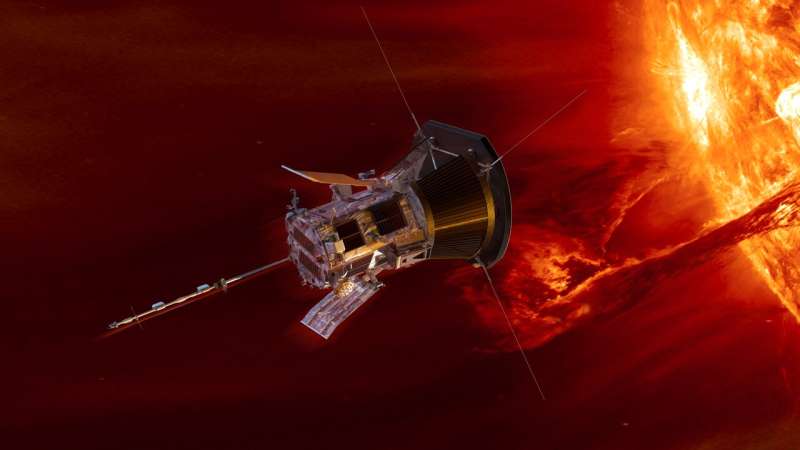
Copernical Team
To Seitah and Back
 Six months ago, we began the dedicated investigation of the Jezero crater floor, and now in December 2021 we are more than halfway through this first science campaign. Since our first sampling experience at Roubion and our first sample pair from the Rochette rock, we have collected a second sample pair, this time from a region of the crater floor called Seitah at the Brac rock. As we now gear up
Six months ago, we began the dedicated investigation of the Jezero crater floor, and now in December 2021 we are more than halfway through this first science campaign. Since our first sampling experience at Roubion and our first sample pair from the Rochette rock, we have collected a second sample pair, this time from a region of the crater floor called Seitah at the Brac rock. As we now gear up Locked in stone: Research may answer the question of Mars' missing water
 Rivers and streams once flowed across the surface of Mars, etching channels still evident on the planet's surface today. Water in lakes once lapped ancient shores.
All told, the geological evidence adds up to an ocean's worth of water, noted Geological Sciences and Environmental Studies Professor David Jenkins. But today, Mars' red sands appear bone-dry. Where did all that water go?
Rivers and streams once flowed across the surface of Mars, etching channels still evident on the planet's surface today. Water in lakes once lapped ancient shores.
All told, the geological evidence adds up to an ocean's worth of water, noted Geological Sciences and Environmental Studies Professor David Jenkins. But today, Mars' red sands appear bone-dry. Where did all that water go? NASA's Perseverance Mars Rover Makes Surprising Discoveries
 Scientists with NASA's Perseverance Mars rover mission have discovered that the bedrock their six-wheeled explorer has been driving on since landing in February likely formed from red-hot magma. The discovery has implications for understanding and accurately dating critical events in the history of Jezero Crater - as well as the rest of the planet.
The team has also concluded that rocks in
Scientists with NASA's Perseverance Mars rover mission have discovered that the bedrock their six-wheeled explorer has been driving on since landing in February likely formed from red-hot magma. The discovery has implications for understanding and accurately dating critical events in the history of Jezero Crater - as well as the rest of the planet.
The team has also concluded that rocks in NASA 'Fires Up' Artemis RS-25 Rocket Engines with New Components
 NASA conducted a successful full-duration test Dec. 15 to begin a new series of testing for state-of-the-art RS-25 engines to help power the agency's Space Launch System (SLS), America's new deep-space rocket, on future missions to the Moon and Mars.
The first hot fire of the new series was conducted for a full-duration 500 seconds on the Fred Haise Test Stand (formerly A-1 Test Stand) at
NASA conducted a successful full-duration test Dec. 15 to begin a new series of testing for state-of-the-art RS-25 engines to help power the agency's Space Launch System (SLS), America's new deep-space rocket, on future missions to the Moon and Mars.
The first hot fire of the new series was conducted for a full-duration 500 seconds on the Fred Haise Test Stand (formerly A-1 Test Stand) at NASA Completes Upper Part of Artemis II Core Stage
 NASA has completed assembly of the upper, or forward, part of the core stage for the Space Launch System (SLS) rocket that will send the Artemis II crew on their lunar mission. Boeing, the lead core stage contractor, completed joining the forward part of the rocket, and then lifted it out of the assembly structure at NASA's Michoud Assembly Facility in New Orleans.
To construct this part o
NASA has completed assembly of the upper, or forward, part of the core stage for the Space Launch System (SLS) rocket that will send the Artemis II crew on their lunar mission. Boeing, the lead core stage contractor, completed joining the forward part of the rocket, and then lifted it out of the assembly structure at NASA's Michoud Assembly Facility in New Orleans.
To construct this part o Launch of GeeSAT commercial satellites fails
 The launch of a pair of GeeSAT commercial satellites, carried by a Kuaizhou-1A carrier rocket, was unsuccessful, the launch center said in a statement Wednesday.
Abnormal performance was detected during the flight of the rocket, which lifted off from the Jiuquan Satellite Launch Center in northwest China at 10 a.m. (Beijing Time).
The cause of the failure is under investigation, acco
The launch of a pair of GeeSAT commercial satellites, carried by a Kuaizhou-1A carrier rocket, was unsuccessful, the launch center said in a statement Wednesday.
Abnormal performance was detected during the flight of the rocket, which lifted off from the Jiuquan Satellite Launch Center in northwest China at 10 a.m. (Beijing Time).
The cause of the failure is under investigation, acco Watching the blink of a star to size up asteroids for NASA's Lucy Mission

Gathering near Las Vegas recently, dozens of astronomers spread throughout the region, pointed their telescopes at the sky and waited for the moment on Oct. 20 that the light from a faraway star blinked out.
It was an event so miniscule it would have been easy to miss. Yet the data gathered in those few seconds will contribute to the success of NASA's Lucy mission, which launched from Cape Canaveral Space Force Station in Florida on Oct. 16.
The star appeared to briefly blink out because the asteroid Eurybates had passed in front of it. Eurybates is one of a handful of asteroids Lucy will visit over the next 12 years.
As Eurybates eclipsed the star, a phenomenon scientists call an "occultation," a 40-mile- (300-kilometer-) wide shadow the size of the asteroid passed over the region.
Astronomers spy quartet of cavities from giant black holes

Scientists have found four enormous cavities, or bubbles, at the center of a galaxy cluster using NASA's Chandra X-ray Observatory. This unusual set of features may have been caused by eruptions from two supermassive black holes closely orbiting each other.
Galaxy clusters are the largest structures in the universe held together by gravity. They are a mixture of hundreds or even thousands of individual galaxies, enormous amounts of hot gas, and unseen dark matter. The hot gas that pervades clusters contains much more mass than the galaxies themselves, and glows brightly in X-ray light that Chandra detects. An enormous galaxy is usually found at the center of a cluster.
A new Chandra study of the galaxy cluster known as RBS 797, located about 3.9 billion light-years from Earth, uncovered two separate pairs of cavities extending away from the center of the cluster.
Inaugural Space Resources Challenge for driving and walking rovers

Driving and walking rovers competed to survey a shadowy analog of the south polar lunar surface for useable resources during the inaugural ESA-ESRIC Space Resources Challenge. Some 13 teams from across Europe and Canada took part in last month's field test, with the winners due to be announced shortly.
The Space Resources Challenge—supported by ESA and the European Space Resources Innovation Centre (ESRIC) in Luxembourg—is asking European (and Canadian) researchers and institutions to develop and demonstrate a system of one or more vehicles capable of prospecting resources on the Moon in the near future.
Massimo Sabbatini, overseeing the contest for ESA, comments: "ESA is analyzing the results of the first field test of the Challenge and the competition is fierce. There was a wide range of participants and technological solutions to the problem of prospecting: notably different locomotion techniques—legged, wheeled, tracked, and so on—and approaches, such as single versus multiple vehicles and aerial vehicles. The jury is out!"
The emphasis of the contest is on prospecting: pinpointing promising resources within a difficult lunar environment then characterizing them in as much detail as possible, such as through visual inspection or spectral analysis.
NASA scientist discusses Parker's journey to the sun

Sixty years ago, NASA set an out-of-this-world goal: to touch our sun. Sending a spacecraft to the fiery star at the center of our solar system is no small feat. From engineering a spacecraft that could hurtle 430,000 mph through space to agreeing on what kinds of data it would capture, there was a lot to sort out. A half-century in the making, Parker Solar Probe finally launched in 2018. Now, three years later, it has touched the sun.
NASA Program Scientist Kelly Korreck serves as head of science operations and project manager for the Solar Wind Electrons Alphas and Protons, or SWEAP, investigation. SWEAP is one of four instrument suites aboard Parker Solar Probe. SWEAP includes a cup that sits outside the spacecraft's heatshield to scoop up some of the sun's plasma.
